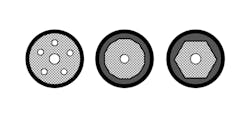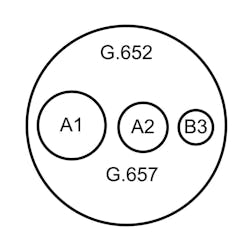The introduction of singlemode fiber 40 years ago was nothing short of monumental. I remember the researchers at Bell Labs who introduced me to fiber optics in the late 1970s telling me that the multimode fiber they were using for early field trials was a poor compromise. Singlemode fiber was coming once some developmental hurdles were overcome; mainly achieving tighter tolerances on the geometry of the fiber and connectors. Corning solved the fiber problems for the first networks in 1983.
The rest is history, but it did not come easy. Early versions of the singlemode AT&T Biconic connectors required grinding to center the fiber core. Early 1310 lasers had a horrific failure rate. But fusion splicers adapted to the new fibers well. Ceramic ferrules for connectors introduced in the mid-80s solved the connection problem. As they say, the rest is history.
Now billions of kilometers of singlemode fiber, mostly made to the ITU G.652 standard, carry the world’s communications. Most of us just take singlemode fiber for granted because it’s ubiquitous and works like we expect it to.
But sometimes things we take for granted don’t stay the same forever. Or something new surfaces to challenge them. Both are true for singlemode fiber.
What’s changing in singlemode fiber? I’ve investigated three new developments recently. Two, multicore fiber and hollow core fiber, are both radical technologies offered to solve special problems. The third is simply technological evolution.
Multicore fiber is just what it says, a standard 125-micron OD glass fiber with two, four, or more singlemode cores arrayed around the circular cladding. The idea is simple; more cores mean more transmission links in a single fiber, a big advantage for cables with a limited number of fibers like submarine cables or in high density applications like data centers where it is being used now (see Figure 1).
The execution is more complex. The preform to make such a fiber is complex and the geometry must be precise to allow splicing with low loss at every core. Make the cores too close together and you get crosstalk. Splicing alignment is more complex, requiring both X-Y movement and rotation to align the cores. How do you make a breakout cable? But development of multicore fiber is progressing, and some is becoming commercially available.
Hollow core fiber is not what you think. I recently read a news article that described optical fiber as a hollow glass tube that transmits light down the hole in the center. That mistake has been made many times since fiber optics began many years ago. The light carrying core of the optical fiber everybody uses today is very pure solid glass, of course, but “hollow glass tube” doesn’t describe hollow core fiber either. The actual fiber structure looks like a honeycomb to confine the light properly (see Figure 2).
Hollow core fiber is already being used in specialty applications. What’s the appeal of hollow core fiber? Speed. Not the bandwidth version of speed but the “how fast can you get a signal from here to there” speed. The hollow core is filled with air or a vacuum and light travels ~50% faster in air or a vacuum than it does in glass. That makes for a difference of ~1.5 microseconds per kilometer, and that difference in time makes a big difference to some users like high-speed stock traders who want the lowest latency they can get in communication links.
Some hollow core fiber is available now. You can buy it in quantity, and it can be cabled for building networks. If you are a high-speed stock trader, it might be just what you are looking for, but it’s not for everybody.
The third development is one that you are probably benefitting from already. You’ve probably heard about bend-insensitive (BI) fiber, fiber that can be bent in small diameters or packed densely in microcables or high fiber count cables without incurring high losses due to stress. BI fiber has been around for a while, long enough to get its own ITU designation, G.657 (see Figure 3).
FOA was recently working with one of our technical advisors, Joe Botha of Triple Play Fiber Optics in South Africa, to answer a technical question from an installer. Joe has done studies on the ability to fusion splice various types of fibers and had some recent data which he shared with us.
“Most of us just take singlemode fiber for granted because it’s ubiquitous and works like we expect it to.”
I decided to contact a couple of fiber manufacturers to find out. Here is what they said:
Corning: The industry is moving towards a G.657. A specification in fiber, because the industry is moving towards smaller denser cables in the network and the bend resilience is a requirement for the cable design.
OFS: The simple answer is most SMF is moving to G.657.A1. OFS’ AllWave+ and Corning’s Ultra fiber—which are among the most deployed fibers in America right now—are both examples of this trend.
Both told us that the design of BI fiber has evolved to have a mode field diameter (MFD) more like regular singlemode fiber, so the splicing compatibility is excellent and the OTDR testing issues (gainers and losers) greatly reduced.
So singlemode fiber is moving to being mostly BI fiber, exactly what happened with 50/125 laser optimized fibers a decade ago. You get a better, more resilient fiber and with the new fiber compatibility is not an issue. But you might check with the cable manufacturer if you are not sure what fiber is being used in the cable you are purchasing or installing.
About the Author
Jim Hayes
Fiber Optic Expert
Jim Hayes is the Fiber Optic Expert columnist for ISE Magazine. He is a lifelong techie who has been involved in the fiber optic industry since the late 1970s. He founded one of the world's first fiber optic test equipment companies, FOTEC, which was acquired by Fluke in 2000, and he was a co-founder of the Fiber Optic Association (FOA), the international professional society of fiber optics, in 1995.
Jim is a writer and trainer and the President of FOA. He is the author of nine books on fiber optics and cabling and writes for several magazines.
Jim and his wife, Karen, who is the GM of the FOA, have traveled the world for the FOA helping set up schools to train the workers who design, build, and operate today's communications networks. The FOA offers nearly 1,000 pages of online technical materials, over 100 videos, and two dozen free self-study courses online.
For more information, email [email protected] or visit www.jimhayes.com.
To learn more about The Fiber Optic Association, visit www.thefoa.org. Follow them on Facebook: FiberOpticAssociation, LinkedIn: company/the-fiber-optic-association-inc-foa, and YouTube: user/thefoainc.




